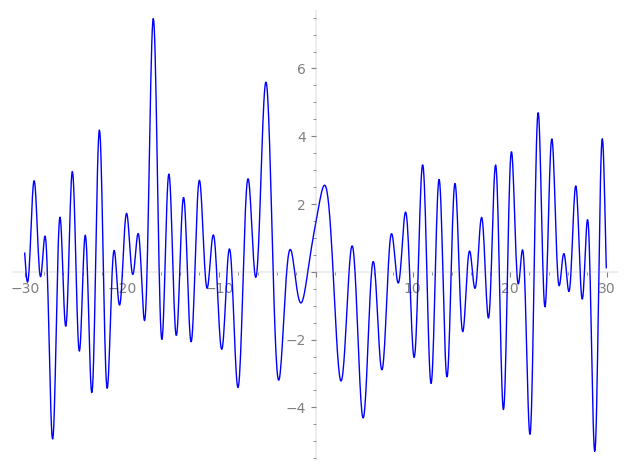| L(s) = 1 | + (−0.5 − 0.866i)2-s + (0.5 − 0.866i)3-s + (0.500 − 0.866i)4-s + (0.5 + 0.866i)5-s − 0.999·6-s − 3·8-s + (−0.499 − 0.866i)9-s + (0.499 − 0.866i)10-s + (−0.499 − 0.866i)12-s + 6·13-s + 0.999·15-s + (0.500 + 0.866i)16-s + (1 − 1.73i)17-s + (−0.499 + 0.866i)18-s + (−4 − 6.92i)19-s + 20-s + ⋯ |
| L(s) = 1 | + (−0.353 − 0.612i)2-s + (0.288 − 0.499i)3-s + (0.250 − 0.433i)4-s + (0.223 + 0.387i)5-s − 0.408·6-s − 1.06·8-s + (−0.166 − 0.288i)9-s + (0.158 − 0.273i)10-s + (−0.144 − 0.249i)12-s + 1.66·13-s + 0.258·15-s + (0.125 + 0.216i)16-s + (0.242 − 0.420i)17-s + (−0.117 + 0.204i)18-s + (−0.917 − 1.58i)19-s + 0.223·20-s + ⋯ |
Λ(s)=(=(735s/2ΓC(s)L(s)(−0.701+0.712i)Λ(2−s)
Λ(s)=(=(735s/2ΓC(s+1/2)L(s)(−0.701+0.712i)Λ(1−s)
| Degree: |
2 |
| Conductor: |
735
= 3⋅5⋅72
|
| Sign: |
−0.701+0.712i
|
| Analytic conductor: |
5.86900 |
| Root analytic conductor: |
2.42260 |
| Motivic weight: |
1 |
| Rational: |
no |
| Arithmetic: |
yes |
| Character: |
χ735(361,⋅)
|
| Primitive: |
yes
|
| Self-dual: |
no
|
| Analytic rank: |
0
|
| Selberg data: |
(2, 735, ( :1/2), −0.701+0.712i)
|
Particular Values
| L(1) |
≈ |
0.555565−1.32566i |
| L(21) |
≈ |
0.555565−1.32566i |
| L(23) |
|
not available |
| L(1) |
|
not available |
L(s)=p∏Fp(p−s)−1 | p | Fp(T) |
|---|
| bad | 3 | 1+(−0.5+0.866i)T |
| 5 | 1+(−0.5−0.866i)T |
| 7 | 1 |
| good | 2 | 1+(0.5+0.866i)T+(−1+1.73i)T2 |
| 11 | 1+(−5.5−9.52i)T2 |
| 13 | 1−6T+13T2 |
| 17 | 1+(−1+1.73i)T+(−8.5−14.7i)T2 |
| 19 | 1+(4+6.92i)T+(−9.5+16.4i)T2 |
| 23 | 1+(4+6.92i)T+(−11.5+19.9i)T2 |
| 29 | 1+2T+29T2 |
| 31 | 1+(−2+3.46i)T+(−15.5−26.8i)T2 |
| 37 | 1+(−1−1.73i)T+(−18.5+32.0i)T2 |
| 41 | 1−6T+41T2 |
| 43 | 1−4T+43T2 |
| 47 | 1+(−4−6.92i)T+(−23.5+40.7i)T2 |
| 53 | 1+(5−8.66i)T+(−26.5−45.8i)T2 |
| 59 | 1+(−2+3.46i)T+(−29.5−51.0i)T2 |
| 61 | 1+(1+1.73i)T+(−30.5+52.8i)T2 |
| 67 | 1+(2−3.46i)T+(−33.5−58.0i)T2 |
| 71 | 1+12T+71T2 |
| 73 | 1+(1−1.73i)T+(−36.5−63.2i)T2 |
| 79 | 1+(4+6.92i)T+(−39.5+68.4i)T2 |
| 83 | 1−4T+83T2 |
| 89 | 1+(3+5.19i)T+(−44.5+77.0i)T2 |
| 97 | 1−18T+97T2 |
| show more | |
| show less | |
L(s)=p∏ j=1∏2(1−αj,pp−s)−1
Imaginary part of the first few zeros on the critical line
−10.21513019721889744588714716247, −9.142671875229193952026188171827, −8.652693295096881803388888080875, −7.46699723572523875021634620936, −6.30232677462348876300017408378, −6.06215823738007843248542834061, −4.38811972194348669394918723538, −2.99376094750741457280557848510, −2.17265511341079055014304820807, −0.816880209091725251028262654467,
1.79144008333543833352681486237, 3.43584376871147869793226047999, 4.05053938266912190787151039746, 5.75599649755096734032464695844, 6.10687461110529749998803352213, 7.45495127667200245001312433880, 8.287735619010345288068790827385, 8.714492154223897861050509021309, 9.673084331152652731725376117625, 10.56324952502121165516736973958

